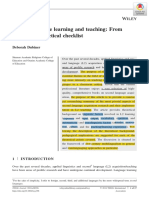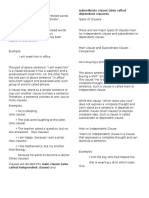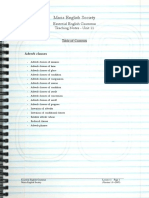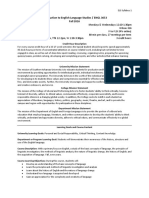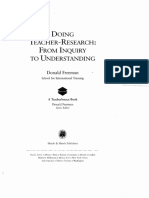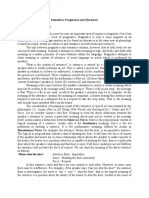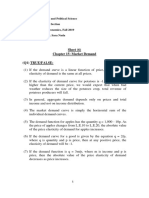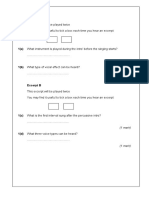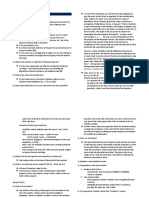Course Title: Foundations of Language and Linguistics
Course No. : Eng. Ed. 416 Full marks: 80 T+20 P
Nature of course: Theory and Practical Pass marks: 28T+ 8P
Level: B. Ed. Four Year Periods per week: 6
Year: First Total periods: 150
Time per period: 55 minutes
1. Course Description
This is a foundation course on language and linguistics to orient the students with the basic knowledge of
language and linguistic. It deals with different concepts and dichotomies related to linguistics. It also
introduces different levels and areas of language and linguistics such as phonetics and phonology,
morphology and syntax, semantics, pragmatics and discourse analysis. It further includes the applications
of linguistic knowledge into language teaching. The students will demonstrate their skills in applying
linguistic theories in their practical fields.
2. General Objectives
The general objectives of the course are as follows:
To acquaint the students with the basic concepts of the English language and linguistics.
To make the students able to analyse speech sounds on articulatory terms i.e. to identify, describe and
classify them.
To introduce the students to the sound system of the English language.
To provide the students with an overview of morphology and syntax.
To acquaint the students with the key concepts of semantics, pragmatics and discourse analysis.
To familiarize the students with the language history, change and variations.
To develop in students the ability to apply the knowledge of linguistics to language teaching.
3. Specific Objectives and Contents
Specific Objectives Contents
Define language and linguistics. Unit I: Preliminaries of Language and Linguistics (20)
Describe the origin and characteristics of 1.1 Definition of language and linguistics
language. 1.2 The origin of language
Explain language as a system of system. 1.3 Characteristics of language
Differentiate language from animal 1.4 Language and animal communication
communication. 1.5 Language as a system of systems
Explain the levels and varieties of language. 1.6 Levels of language
Classify linguistics into various branches. 1.7 Varieties of language
Define key concepts of linguistics. 1.7.1 Dialect: geographical and social
1.7.2 Register: field based, mode based and tenor
based
1.7.3 Idiolect
1.8 Branches of linguistics
1.8.1 Theoretical linguistics and applied linguistics
1.8.2 Synchronic linguistics and diachronic linguistics
1.8.3 General linguistics and descriptive linguistics
1.8.4 Micro linguistics and macro linguistics
1.8.5 Psycho linguistics and socio-linguistics
1.8.6 Developmental linguistics
1.8.7 Neuro-linguistics
40
� 1.8.8 Computational linguistic
1.8.9 Ethno-linguistics
1.9 Key concepts in language and linguistics
1.9.1 Langue and parole
1.9.2 Competence and performance
1.9.3 Relationship among form, function, substance
and meaning
1.9.4 Speech and writing
1.9.5 Orthographic writing and phonetic writing
1.9.6 Descriptive grammar and prescriptive grammar
1.9.7 Syntagmatic relation and paradigmatic relation
Distinguish between phonetics and Unit II: Phonetics and Phonology (30)
phonology. 2.1 Distinction between phonetics and phonology
Demonstrate how English sounds are 2.2 Phoneme, phone, allophone
produced. 2.3 The organs of speech
Prepare the inventory of English vowels 2.4 The English vowels
and classify them into various categories. 2.4.1 Inventory
List the consonants of the English language 2.4.2 Description of vowels
and classify them. Quality: monophthongs and diphthongs
Describe the English sounds. Length: short and long
Show the syllable structures and consonant Tongue position: a) high, mid, low (close, half-
clusters in English words. close, open, half-open)
Use appropriate supra-segmental features front, central, back
while speaking English. Lip position: rounded and unrounded
Use appropriate stress and intonation. Direction of glide: closing and centring
Define and use the features such as Prominence of glide: falling and rising
deletion, assimilation, linking ‘r’ etc. in 2.5 The consonants
connected speech. 2.5.1 Inventory
2.5.2 Fortis and lenis (strong and weak)
2.5.3 Three term descriptions
Voicing: voiced and voiceless
Place of articulation: bilabial, labio-dental, dental
or inter-dental, alveolar, palato-alveolar, palatal,
velar, glottal
Manner of articulation: stop or plosive, nasal,
fricative, affricate, lateral, frictionless continuant,
semi-vowel or approximant
2.6 Transcriptions: narrow and broad
2.7 Supra-segmental features: length, stress, tone,
intonation, tempo, juncture
2.8 Speech units: phone, syllable, stress unit, tone unit
2.9 Consonant clusters
2.9.1 Word initial clusters
2.9.2 Word final clusters
2.9.3 Word medial clusters
Inter-syllabic clusters
Intra-syllabic clusters
2.10 Vowel sequences
2.10.1 Vowel + sequences
2.10.2 Diphthong + sequences
41
� 2.10.3 Other sequences: within words and across words
2.11 Syllable structures (canonical shapes of words)
(C) (C) (C) V (C) (C) (C) (C)
Co3 V Co4
2.12 Pronunciation in connected speech
2.13 Strong forms and weak forms
2.14 Linking ‘r’ and intrusive ‘r’
2.15 Pronunciation of the suffixes ‘-s’, ‘-es’ and ‘-ed’
2.16 Elision (disappearance)
2.17 Assimilation
2.18 Practical work: oral and written practice
Unit III: Morphology and Syntax (40)
Define morphology and syntax. 3.1 The Morpheme
Classify morphemes. 3.1.1 Definition of morpheme
Form words using different morphological 3.1.2 Free and bound morpheme
combinations. 3.1.3 Morpheme, morph and allomorph
Describe the English phrase and clause 3.2. The word
system. 3.2.1 Definition of word
Classify English sentences into various 3.2.2 Orthographic, morphological, lexical, and
categories. semantic words
Describe, grammatical functions, 3.2.3 Word classes
grammatical operations and grammatical Major: noun, verb, adjective, adverb
categories. Minor: pronoun, preposition, conjunction,
interjection, determiner, intensifier, classifier
3.2.4 Word formation: affixation, modification,
functional homonymy, reduplication,
compounding, shortening, backformation,
blending, borrowing, acronymy, coinage
3.2.5 Derivation and inflection
3.3 The phrase
3.3.1 Definition of phrase
3.3.2 Types of phrase: noun phrase, verb phrase, adverb
phrase, prepositional phrase
3.3.3 Functions of phrase
3.4 The clause
3.4.1 Definition of clause
3.4.2 Types of clause: main clause, coordinate clause,
subordinate clause (noun clause, adjective clause,
adverbial clause)
3.4.3 Functions of subordinate clause
3.5. The sentence
3.5.1 Definition of sentence
3.5.2 Functional classification of sentences: declarative,
imperative, interrogative, exclamatory
3.5.3 Formal classification of sentences: simple,
compound, complex, composite
3.5.4 The basic pattern of the simple English sentence:
(A) (S) (P) (O) (C) (A)
3.6 Grammatical categories: gender, number, person,
case, tense, aspect, mood
42
� 3.7 Grammatical functions: subject, predicate, object,
complement, adjunct
3.8 Grammatical transformations: negation, contraction,
question, passivization
3.9 Grammatical operations: insertion, deletion,
substitution, transposition
Define semantics, pragmatics and discourse Unit IV: Semantics, Pragmatics and Discourse Analysis
analysis. (20)
Explain various types of meaning. 4.1 Semantics
Define and examplify different semantic 4.1.1 Meaning: conceptual and associative meaning,
terms that include synonymy, antonymy, denotative and connotative meaning
hyponymy, homonymy, metonymy 4.1.2 Sense relations
collocation. 4.1.2.1 Synonymy
Describe the features of pragmatics. Absolute and partial synonymy
Describe the basic concepts of discourse Descriptive and cognitive synonymy
analysis. Stylistic synonymy
Dialectal synonymy
Intralingual synonymy and interlingual synonymy
4.1.2.2 Antonymy
Gradable antonymy
Complementarity
Converseness
4.1.2.3 Hyponymy: hypernym (superordinate) and
hyponym
4.1.2.4 Homophony and homography
4.1.2.5 Homonymy and polysemy
4.1.2.6 Metonymy and collocation
4.2 Pragmatics
4.2.1 Invisible meaning
4.2.2 Context
4.2.3 Deixis
4.2.4 Reference
4.2.5 Inference
4.2.6 Anaphora
4.2.7 Presupposition
4.2.8 Speech acts
4.2.9 Politeness
4.3. Discourse Analysis
4.3.1 Interpreting discourse
4.3.2 Cohesion
4.3.3 Coherence
4.3.4 Speech events
4.3.5 Conversational analysis
4.3.6 Turn-taking
4.3.7 The co-operative principle
4.3.8 Hedges
4.3.9 Implicatures
4.3.10 Background knowledge
4.3.11 Schemas and scripts
43
� List the language families Unit V: Language History and Change (10)
Describe language history and change. 5.1 Historical linguistics
5.2 Language families
5.3 Language change
5.4 Sound change
5.5 Lexical change
5.6 Syntactic change
5.7 Semantic change
Apply the knowledge of linguistics in Unit VI: Pedagogical Implications of Linguistics (30)
language teaching. 6.1. Linguistics and language teaching
Compare and contrast languages. 6.2. Contrastive analysis
Analyse learners’ errors. 6.2.1 What is CA?
6.2.2 CA hypothesis: Transfer theory
6.2.3 Principles of CA
6.2.4 Assumptions of CA
6.2.5 The uses of CA
6.2.6 Practical work
6.3. Error analysis
6.3.1 What is EA?
6.3.2 Lapses, mistakes and errors
6.3.3 Stages of error: recognition, description and
explanations of error
6.3.4 The uses of EA
6.3.5 Practical work
Note: The figures in the parentheses indicate the approximate periods for the respective units.
4. Instructional Techniques
The instructional techniques for this course are divided into two groups. The first group consists of
general instructional techniques applicable to most of the units. The second group consists of specific
instructional techniques applicable to specific units.
4.1 General Instructional Techniques
Lecture and discussion
Demonstration
Explanation and illustration
Group and individual work
4.2 Specific Instructional Techniques
Unit VI: Project work
Unit II: Classroom presentation
44
�5. Evaluation and Time Allotment
The course is for one academic year and it carries 100 marks. The distribution of marks and time allotment is as
follows:
Unit Marks Time
Unit I: Preliminaries of Language and Linguistics 15 15%
Unit II: Phonetics and Phonology 20 20%
Unit III: Morphology and Syntax 15 15%
Unit IV: Semantics, Pragmatics and Discourse Analysis 20 20%
Unit V: Language History and Change 10 10%
Unit VI: Pedagogical Implications of Linguistics 20 20%
Theory Part
There will be a written examination of 80 marks and 20 marks have been allocated for practical examination. The
type of questions and number of test items to be asked in the final exam is as follows:
Number of questions
Total questions Total
Types of questions to be answered and marks
to be asked marks
allocated
Group A: Multiple 16 questions 16 x 1 mark 16
choice items
Group B: Short answer 8 with 3 'or' questions 8 x 5 marks 40
questions
Group C: Long answer 2 with 1 'or' question 2 x 12 marks 24
questions
Practical Part (20%)
(10% from Sounds and 10% from Contrastive Analysis and/or Error Analysis Project Work)
The distribution of marks for internal and external examiners is as follows:
Criteria Internal External
Portfolio of the practical activities 4 4
mentioned in the course
Interview 4 8
6. Recommended Books and References
Recommended Books
Corder, S. P. (1973). Introducing applied linguistics. Hardmondsworth: Penguin. (For unit VI)
Lyons, J. (2002). Language and linguistics: An introduction. Cambridge: Cambridge University Press. (For
units I to V).
Roach, P. (2007). English phonetics and phonology. Cambridge: Cambridge University Press. (For unit II)
Todd, L. (1991). An Introduction to linguistics. London: Longman. (For unit III)
Verma, S. K. & Krishnaswamy, N. (1989). Modern linguistics. An introduction. Delhi: Oxford University Press.
(For unit VI)
Yule, G. (2008). The study of language. Cambridge: Cambridge University Press. (For units III to V)
45
� References
Crystal, D. (2003). A dictionary of linguistics and phonetics. Cornwell: Blackwell.
Crystal, D. (1971). Linguistics. harmondsworth. Penguin Books.
Els, T. V. ; Bongaerts, T. ; Extra, G. ; Os, C. V. & Dieten, A. J. (1984). Applied linguistics and the learning and
teaching of foreign languages. London: Edward Arnold.
Ledefoged, P. (2006). A course in phonetics. Los Angeles: Thomson Wadsworth.
Linguistic Society of Nepal. Nepalese Linguistics. Kathmandu: Annual Journal of Linguistic Society of Nepal.
Matthews, P. H. (1997). Oxford concise dictionary of linguistics. New York: Oxford University Press.
Matthews, P. H. (2003). Linguistics: a very short introduction. New York: Oxford University Press
Palmer, F. R. (1996). Semantics. Cambridge: Cambridge University Press.
Procter, P. (2006). Cambridge advanced learner’s dictionary. Third Edition. Cambridge. Cambridge University
Press.
Radford, A., Atkinson, M., Britain, D., Clahsen, H. & Spencer, A. (2002). Linguistics: An introduction.
Cambridge: Cambridge University Press.
46



